Gujarat Board GSEB Textbook Solutions Class 12 Biology Chapter 5 Principles of Inheritance and Variation Textbook Questions and Answers, Additional Important Questions, Notes Pdf.
Gujarat Board Textbook Solutions Class 12 Biology Chapter 5 Principles of Inheritance and Variation
GSEB Class 12 Biology Principles of Inheritance and Variation Text Book Questions and Answers
Question 1.
Mention the advantages of selecting pea plant for the experiment by Mendel.
Answer:
Mendel selected pea plant because:-
- It possesses a large number of varieties.
- Pure varieties of this plant were available.
- The plant is small and the flower is large enough to hand it manually.
- Flowers are bisexual and produce fertile hybrids.
- Each plant produces a large number of seeds.
- Plants are self-pollinated and can be cross-pollinated.
- The plant is annual with a growth period of few months.
- Chances of contamination are very less.
![]()
Question 2.
Differentiate between the following:
a. Dominance and Recessive
b. Homozygous and Heterozygous
c. Monohybrid and Dihybrid.
Answer:
a. In Mendel’s experiment of the law of dominance, the expressed character is called dominant character or dominance, and suppressed character is called recessive character or recessiveness.
b. The individual whose chromosome carries similar genes for a character is called homozygous and the individual whose chromosome carries dissimilar genes for a character is called heterozygous.
c. A cross involving two plants differing in one character pair is called a monohybrid cross and that in two characters is called a dihybrid cross.
Question 3.
A diploid organism is heterozygous for 4 loci, how many types of gametes can be produced?
Answer:
Number of gametes = 2n
n = Number of loci, n = 4
So, 24 = 2×2×2×2 = 16 types of gametes.
![]()
Question 4.
Explain the Law of Dominance using a monohybrid cross.
Answer:
This law states that when a pair of contrasting factors for a character are present together, one dominates over the other. This law is used to explain the expression of only one of the parental characters in a monohybrid cross in the F1 and the expression of both in the F2. It also explains the 3 : 1 ratio of F2 generation.
Question 5.
Define and design a test-cross.
Answer:
The crossing of an F1 hybrid with its recessive parent is called a test cross.
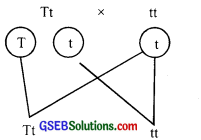
Question 6.
Using a Punnett Square, work out the distribution of phenotypic features in the first filial generation after a cross between a homozygous female and a heterozygous male for a single locus.
Answer:
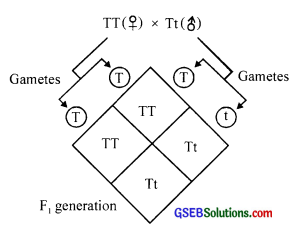
![]()
Question 7.
When a cross is made between a tall plant with the yellow seed (TtYy) and a tall plant with the green seed (Ttyy), what proportions of phenotype in the offspring could be expected to be
a. tall and green.
b. dwarf and green.
Answer:
Tall and green = 3
Dwarf and green = 1
Question 8.
Two heterozygous parents are crossed. If the two loci are linked what would be the distribution of phenotypic features in F1 generation for a dihybrid cross?
Answer:
The parental phenotypes appear much in excess than expected. It is due to linkage and the absence of independent assortment.
Question 9.
Briefly mention the contribution of T.H. Morgan in genetics.
Answer:
TH Morgan is a Geneticist who got Nobel Prize.
- He found fruit fly (Drosophila Melanogaster) to be an experimental material as it was easy to rear and multiply.
- The established presence of genes over the chromosomes.
- Principle of linkage and crossing over.
- Discovered sex linkage and crossing over.
- He observed mutations.
- The developed technique of chromosome mapping,
- Wrote the book “The theory of Gene”.
Question 10.
What is pedigree analysis? Suggest how such an analysis, can be useful.
Answer:
Analysing the inheritance of the character through several previous generations in a family is called pedigree analysis. This is a very useful method to study human genetics. Human beings have a long generation time and produce extremely small number of offspring which make human genetic studies difficult. In pedigree analysis inheritance of a particular trait is studied in several generations of a family. The ancestral history of an individual is called pedigree. This data is used to produce a family tree. In this method of pedigree analysis the studies of trait as they have appeared in a given family line for several past generations can be done.
![]()
Question 11.
How is sex determined in human beings?
Answer:
In human beings, out of 23 pairs of chromosomes present, 22 pairs are same in both sexes. These chromosomes are called autosomes (the chromosomes determine the body characters other than sex). In human female, there are two X chromosomes whereas in male one X chromosome and one Y chromosome. During spermatogenesis two types of sperms are produced (heterogametic male) i.e., 50 percent of the sperm produced carry X chromosome and 50 percent carry Y chromosome.
Females are homogametic i.e., produce only one type of egg with X chromosome. Sex of the baby is determined by the type of sperm that fertilises the egg. If the egg is fertilised by a sperm that carries X chromosome, the resulting baby will be a female and if the egg is fertilised by the sperm that carries Y chromosome, the resulting baby will be a male. Thus it is evident that in each pregnancy there is always 50 percent probability of either a male or a female child. Unfortunately, the society blames the female for producing female children and have been ostracised and ill-treated because of this false notion.
Question 12.
A child has blood group O. If the father has blood group A and mother blood group B, work out the genotypes of the parents and the possible genotypes of the other offspring.
Answer:
Father IAi
Mother IBi
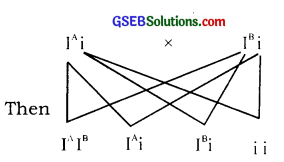
The possible other genotypes IAIB i.e., AB, IAi i.e., A and IBi i.e., B group.
Question 13.
Explain the following terms with examples.
a. Co-dominance
b. Incomplete dominance
Answer:
(a) Co-dominance: Phenomenon of 2 different alleles of same gene lacking dominance – recessive relationship and expressing their effect simultaneously in the heterozygote.
Eg: 1A and 1B alleles in the AB blood group of humans.
(b) Incomplete dominance: Phenomenon of neither of 2 alleles of a gene being dominant over each other so that when both of them are present together, a new phenotype is formed which is somewhat intermediate between both of their independent expression. Eg: Flower colour is Snapdragon and a 4’0 clock plant.
![]()
Question 14.
What is point mutation? Give one example.
Answer:
The changes occurring in the structure of a gene are called point mutations or gene mutations, e.g. Sickle cell anemia.
Question 15.
Who had proposed the chromosomal theory of inheritance?
Answer:
Sutton and Boveri
Question 16.
Mention any two autosomal genetic disorders with their symptoms.
Answer:
i. Down’s syndrome: It is an autosomal abnormality first discovered by Langdon Down in 1866. The karyotype of the affected person shows 47 chromosomes instead of 46. It is due to the presence of an extra autosome, which is found along with the 21st pair of autosomes i.e., chromosome 21 is represented by three copies. So this condition is called 21 trisomies. The genetic make-up of the person is 45 A + XX or 45 A + XY.
ii. Edward’s syndrome: It is due to the autosomal trisomy of chromosome 18. The babies born with this syndrome have several skeletal defects, a short deformed sternum, cardiac problems, abnormal kidneys, etc. The incidence of this syndrome is about 1 per 15,000 births. Maternal age is one of the factors that influence its incidence.
GSEB Class 12 Biology Principles of Inheritance and Variation Additional Important Questions and Answers
Question 1.
Match the following.
| A | B |
| a. Mendel | Chromosome theory |
| b. Karl Landsteiner | Genetics |
| c. Sutton and Boveri | Polytene chromosome |
| d. Morgan | Incomplete dominance |
| e. Bateson | Blood groups |
Answer:
| A | B |
| a. Mendel | Incomplete dominance |
| b. Karl Landsteiner | Blood groups |
| c. Sutton and Boveri | Chromosome theory |
| d. Morgan | Polytene chromosome |
| e. Bateson | Genetics |
![]()
Question 2.
a. Name the phenomenon of co-existance of two or more genes in same chromosome,
b. Mention its types.
Answer:
a. Linkage
b. Complete linkage: In this type of linkage, two or more genes or traits are inherited together for a number of generations. This is seen only in male Drosophila.
Incomplete linkage: The linked genes sometimes separate and lead to the formation of new combinations. This is seen in female Drosophila.
Question 3.
What is Genetics?
Answer:
The branch of biology that deals with the inheritance and variation of characters from parents to offspring.
![]()
Question 4.
Write the symptoms of
Haemophilia
Cystic fibrosis
Sickle cell anemia
Colour blindness
Thalassemia
Answer:
Haemophilia – Blood does not clot
Cystic fibrosis – An inherited disease of secretory gland-like mutons and sweat glands.
Sickle cell anaemia – RBC becomes sickle-shaped and will carry only less oxygen.
Colour blindness – Cannot distinguish colours.
Thalassemia – Reduced amount of hemoglobin or its absence.
Question 5.
The following are the symbols shown in pedigree analysis. Identify them.
![]()
Answer:
a. Mating between relatives
b. Female
c. Male
d. Affected female
![]()
Question 6.
Complete the flowchart on the criss-cross inheritance seen in human beings.
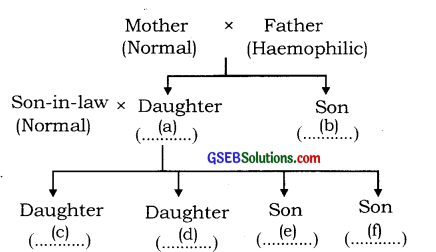
Answer:
a. Carrier
b. Normal
c. Normal
d. Carrier
e. Normal
f. Haemophilic
Question 7.
Note the relationship between the first two words and suggest a suitable word for the 4th place.
a. Genetics – Bateson :: Genes –
b. Visible characters of an organism – Phenotype :: Genetic constitution of an organism –
c. Epigenesis – Wolf :: Blending inheritance –
d. Multiple alleles – Blood group :: Polygenic traits –
e. Heredity – Resemblance between parents and offspring :: Variation –
f. Garden pea – Pisum sativum :: Sweet pea –
g. Monohybrid ratio – 3:1 :: Dihybrid ratio –
Answer:
a. Johannsen
b. Genotype
c. Galton
d. Skin colour
e. Difference between parents and offspring
f. Lathyrus odoratus g. 9 : 3 : 3 : 1
![]()
Question 8.
Find out the odd one in each group.
a. 3 : 1, 1 : 2 : 1, 9 : 3 : 3 : 1, 9:7
b. Homozygous, Heterozygous, Hemizygous, Azygous
c. Monohybrid, Dihybrid, Polyhybrid, Back cross
d. Tall, Axial, Purple, White
Answer:
a. 9 : 7
b. Azygous
c. Back cross
d. White
Question 9.
What is a monohybrid cross?
Answer:
The cross made between individuals of a species, considering the inheritance of the contrasting pair of a single character.
Question 10.
Name a plant that shows incomplete dominance in respect to the colour of its flowers.
Answer:
Mirabilis jalapa (4 o’clock plant)
Question 11.
A heterozygous tall plant is crossed with a homozygous dominant plant. What is the result in F1 F22 generations? Explain with adequate illustration.
Answer:
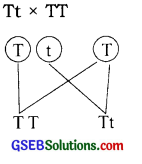
F1 generation
1 Homozygous tall plant
1 Heterozygous tall plant
1 : 1 is the ratio of F1 generation.
Question 12.
Name the scientists who rediscovered Mendelism.
Answer:
Correns (Germany), De Vries (Holland), Tshermak (Austria)
Question 13.
What do you understand from the following flow chart?
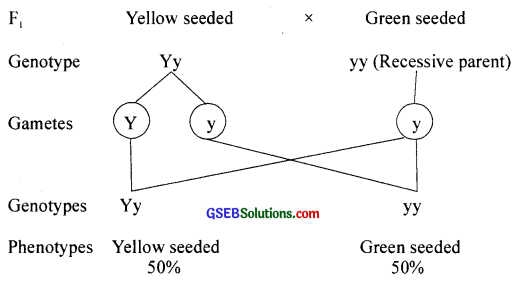
Answer:
The flow chart illustrates the monohybrid test cross.
Question 14.
What do the following genetic symbols mean?
Aa, AA
Answer:
Aa = Heterozygous
AA = Homozygous dominant
Question 15.
A man with blood group A marries a woman with blood group B. Their child has blood group O.
a. What are the genotypes of their parents?
b. What are the other genotypes and in what ratio would you expect in the offspring from this marriage?
Answer:

b. The other possible genotynes are AB, A and B. The ratio is 1 : 1 : 1 : 1 (AB : A : B : O)
Question 16.
Give reason.
a. Mendel selected garden pea (Pisum sativum) as his experimental plant.
b. Blood group identification is not required while transfusing serum.
Answer:
a. Garden pea (Pisum sativum) shows a large number of contrasting characters. Moreover the hybrids are fertile, easy to cultivate, short growth period and life cycle, availability of pure breeding varieties etc. All these are the reasons for- the selection of garden pea as his experimental material.
b. Serum does not contain any antigen.
Question 17.
‘Give the scientific name and the common name of plant in which incomplete dominance was first discovered.
Answer:
Four O’clock plant – Mirabilis jalapa.
Question 18.
What does the letter Fx represent in heredity?
Answer:
F1 stands for First Filial generation.
Question 19.
Match the related items from B and C with column A.
| A- Blood groups | B – Antigens | C- Antibodies |
| A | B | A |
| B | A | B |
| AB | – | AB |
| O | AB | – |
Answer:
| A- Blood groups | B – Antigens | C- Antibodies |
| A | A | B |
| B | B | A |
| AB | AB | – |
| O | – | AB |
Question 20.
Identify the personality.

Answer:
Gregor Johann Mendel, the Father of Genetics.
Question 21.
What is the glycoprotein found on the RBC’s of a person with blood group AB?
Answer:
Glycoprotein A and B are found.
Question 22.
Match the following.
| A | B |
| i. Incomplete dominance | Punnet |
| ii. Polygenic traits | Blood groups |
| iii. Multiple alleles | Skin colour |
| iv. Checkerboard | Mirabilis jalapa |
Answer:
| A | B |
| i. Incomplete dominance | Mirabilis jalapa |
| ii. Polygenic traits | Skin colour |
| iii. Multiple alleles | Blood groups |
| iv. Checkerboard | Punnet |
Question 23.
Mendel, in his last breath said ‘Meine zeit word schoon kommen’. What is the meaning of it?
Answer:
My time will come soon
Question 24.
Give the scientific names of the following.
4 o’clock plant, Sweet pea, Snapdragon.
Answer:
Mirabilis jalapa, Lathyrus odoratus, Antirrhinum majus
Question 25.
Who discovered blood groups?
Answer:
Karl Landsteiner in 1900
Question 26.
Discuss under what conditions the ratio 9 : 3 : 3 : 1 is modified to 9 : 7 ratio.
Answer:
During complementary gene action, the 9:3:3: 1 is modified to 9 : 7 ratio.
Question 27.
A plant with red flowers was crossed with another plant of the same species with white flowers. The offspring thus obtained were 60 plants with only pink flowers. On selling, these plants produced 60 plants with red flowers, 120 plants with pink flowers, and 60 with white flowers.
a. Name the genetic principle behind this.
b. Give a scientific explanation for this.
c. Name the geneticist who conducted this experiment.
Answer:
a. Balsam plant produces offspring in the ratio of 3 : 1 in crossbreeding.
b. Balsam plant has incomplete dominance. So the cross-breeding produces a new colour, pink.
Pink-colored F1 generation is formed because of polygenic traits.
c. Correns
![]()
Question 28.
All test crosses are back cross. ‘But all backcrosses are not test cross’. Justify the statement.
Answer:
The crossing of F1 hybrid with its recessive parent is called a test cross. Back cross is the crossing of an F1 hybrid back with any of the parents. So all test crosses are back cross. But all backcrosses are not test cross.
Question 29.
Copy and complete the checkerboard of the dihybrid cross. Write the genotypic and phenotypic ratios. Gametes are given.

Answer:
Mendel explained the dihybrid cross graphically by Punnet square or checkerboard.
Let R be the gene for round seed shape and r for wrinkled shape. Y for yellow colour and y for green colour. So the genotype of the pure breeding round yellow plant is RRYY and that of wrinkled green is rryy. The F1 hybrids produce 4 kinds of gametes in equal numbers.
F2 Checkerboard
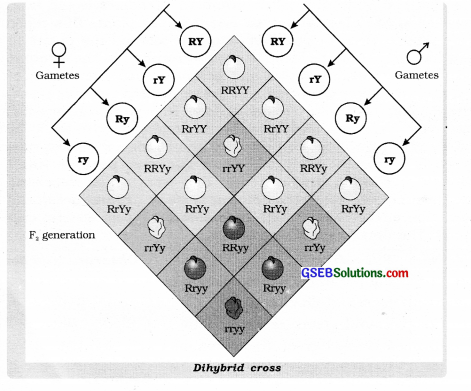
Explanation
During gamete formation of a dihybrid, the gene for round shape assorts out independently of the gene for yellow colour. The gene R may combine with dominant gene Y or the recessive gene y of the other character and enter a gamete. Similarly, the gene r may combine with the dominant gene Y or the recessive gene y and enter a gamete. So the F hybrid plants produce four types of gametes such as RY, Ry, rY and ry. A cross of two such F1 plants produces 16 combinations.
Out of the above 16 combinations, \(\frac{9}{16}\) are round yellow i.e., they have both dominant genes R and Y, \(\frac{3}{16}\) are round green i.e., they have one dominant and one recessive gene R and y, \(\frac{1}{16}\) are wrinkled yellow i.e., they have one dominant gene and one recessive gene r and Y and \(\frac{1}{16}\) is wrinkled green i.e., it has both recessive genes r and y. This ratio 9:3:3:1 is called the dihybrid phenotypic ratio. The genotypic ratio is 1:2:1:2:4:2:1:2:1.
In the dihybrid cross, the formation of new combinations such as round green (Ry) and wrinkled yellow (rY) no doubt, is the result of independent assortment. This law states that when more than one pair of characters are involved in a cross, factor pairs assort independent of each other.
Question 30.
A test cross is used to identify whether the plant is homozygous or heterozygous. Justify this statement.
Answer:
To test the purity of the plant, subject the doubted plant for test cross. If the doubted plant is homozygous, it will produce only one type of progeny. If it is heterozygous, it will produce two types of progeny in the ratio of 1:1.
Question 31.
Note the relationship between the first two words and suggest a suitable word for the 4th place.
a. XX – XO mechanism – Grasshopper ::
XX – XY mechanism –
b. Sex limited inheritance – Beard in man ::
Sex influenced inheritance –
c. Phenylketonuria – Phenylalanine hydroxylase::
Alkaptonuria –
d. Down syndrome – Langdon Down::
Klinefelter’s syndrome –
e. Turner’s syndrome – 45 chromosomes::
Down’s syndrome –
f. Ascaris megalocephaly – 2::
Ophioglossum reticulatum………………..
Answer:
a. Man
b. Baldness in man
c. Homogentisic acid oxidase
d. Harry Klinefelter
e. 47 chromosomes
f. 1262
![]()
Question 32.
Find the odd one of the following.
a. Alkaptonuria, Phenylketonuria, Albinism, Colour blindness
b. Deletion, Duplication, Inversion, Conversion
c. Haploidy, Diploidy, Polyploidy, Polydactyly
d. Nullisomic, Monosomic, Polysomic, Polygenic
e. Klinefelter’s syndrome, Down’s syndrome, Turner’s syndrome, Acquired Immune Deficiency syndrome.
Answer:
a. Colour blindness
b. Conversion
c. Polydactyly
d. Polygenic
e. Acquired Immune Deficiency Syndrome
Question 33.
Give reason.
a. Drosophila is the ideal material for genetic study.
b. Haemophilia is more common in males.
c. Aneuploidy leads to variation.
d. Sex of the child is determined by the father.
Answer:
a. It breeds very quickly, has a short generation time, produces numerous offspring, only 4 pairs of chromosomes, the chromosomes can be easily distinguished with the help of a microscope.
b. It is an ‘X’ linked disorder. Male possesses only one X chromosome. So it is more common in males.
c. Aneuploidy is a chromosomal mutation that causes variation in chromosome number which in turn leads to variation.
d. Father is heterogametic and produces two types of sperms i.e., half with ‘X’ and a half with A” chromosomes.
Question 34.
Construct a flow chart showing criss-cross inheritance.
Answer:
Haemophilia (Bleeder’s disease) is a hereditary sex-linked blood disease in man. It was discovered by John Cotto in 1803. This disease is caused by the absence of an antihaemophilic factor. This disease is also called bleeder’s disease because even minor injuries can cause death due to excessive bleeding. This disease was first reported in the royal families of Europe and Queen Victoria, hence it is also called royal disease.
The genes responsible for haemophilia are located on the ‘X’ chromosome. The ‘Y’ – chromosome carries no gene for this character. Haemophilia is caused by a recessive gene ‘h’. The dominant gene ‘H’ controls normal clotting of blood.

The females have two ‘X’ chromosomes, they may be of the genotype ‘HH’ or ‘Hh’ or ‘hh’. Homozygous dominant females (HH) are normal. Heterozygous females (Hh) are not haemophilic since ‘H’ is dominant over ‘h’. But they will transmit the haemophilia to all their sons. So heterozyous females are called carriers. Homozygous recessive females (hh) will be haemophilic.
A normal woman (HH) marries a haemophilic man (h), all their daughters (Hh) are carriers of disease because the father passes his ‘X’ chromosome only to his daughters. Mothers pass their ‘X’ chromosomes to both sons and daughters. All the songs are normal (H) because the “Y’ chromosome from the father contains no gene for this trait.
It can be noted that haemophilia is transmitted from the father to the grandson through the daughter. So this type of inheritance is said to be a crisscross inheritance or zig-zag inheritance. In females, X-linked recessive genes are expressed only in homozygous conditions (hh). In males, only one ‘X’ chromosome expresses the recessive gene in a single dose ‘h\ So ‘X’- linked disorders are more common in males than in females.
![]()
Question 35.
Observe the following diagrams and identify the different types of chromosomal mutation.

Answer:
A – Deletion
B- Duplication
C – Inversion
D- Translocation
Question 36.
Substitution of a wrong amino acid valine instead of glutamic acid in the 6th position of globin chain of RBC causes disease in man.
a. Name the disease.
b. Draw the amino acid sequence of both normal and diseased Hb.
Answer:
a. Sickle cell anemia
b. This is a genetic defect characterized by sickle-shaped RBC with abnormal Hb. It is due to a gene mutation that causes the substitution of a wrong amino acid valine instead of glutamic acid in the 6th position of the globin chain (beta chain) of RBC. At low oxygen concentration, they interact with each other to form fiber-like structures that distort the RBC membrane and cause the cell to form a sickle shape and is unable to take oxygen. Hence this defect is also known as the sickle – cell crisis. The sickle-shaped erythrocytes (RBC) are destroyed more rapidly than the normal RBC leading to anemia.
This disease is controlled by a pair of alleles namely, HbA Hbs. Pedigree analysis revealed that three genotypes (HbA HbA, HbA Hbs, Hbs Hbs) and two phenotypes (normal and affected) individuals result from homozygous genotypes HbA HbA and HbA Hbs respectively. The third genotype HbA Hbs exhibit sickle cell trait. Though the HbA Hbs individuals are unaffected, they carry one normal gene and one defective gene and can transmit the same to 50 percent of their offspring.
The aminoacid sequence of normal haemoglobin is valine, histidine, leucine, threonine, proline, glutamic acid ………………
The aminoacid sequence of normal haemoglobin is valine, histidine, leucine, threonine, proline, valine …………………….

Question 37.
Who proposed mutation theory of heredity?
Answer:
Hugo de Vries
![]()
Question 38.
Which one of the following is male Drosophila?

Answer:
A – male
B – Female
Question 39.
A man suffering from hemophilia marries a carrier woman. Work out the chances, of their progeny suffering from the disease. Use a flow chart/Punnet square.
Answer:
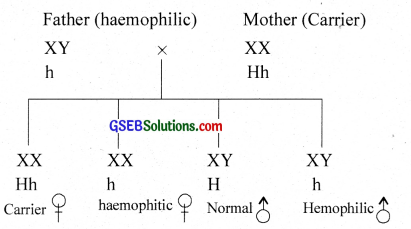
50% of the progeny will be haemophilic and 50% of progeny will be normal.
Question 40.
Match the following.
| A | B |
| a. Mutation theory | Garrod |
| b. Chromosome map | John Cotto |
| c. Haemophilia | Hugo de Vries |
| d. Inborn errors of metabolism | Sturtevent |
Answer:
| A | B |
| a. Mutation theory | Hugo de Vries |
| b. Chromosome map | Sturtevent |
| c. Haemophilia | John Cotto |
| d. Inborn errors of metabolism | Garrod |
![]()
Question 41.
Some so called doctors claim that their medicines provide 100% guarantee for getting a son or a daughter according to the wish of the parent. How do you react to such claims on the basis of your knowledge of genetics? Give a suitable explanation.
Answer:
The claim is not correct, because sex of the foetus is determined by the sex chromosomes. Human females are homogametic and produce only one type of eggs whereas the males are heterogametic and produce two types of sperms. The sex of the foetus depends upon the type of sperm that fertilises the egg.

Question 42.
What will be the sex of a child which develops from 44 + XX zygote?
Answer:
Female
Question 43.
What is haemophilia due to? What happens in this disorder?
Answer:
Haemophilia is due to a defective recessive allele located on the ‘X’ chromosome. In this disorder, a single protein which is involved in the clotting of blood is affected. As a result, the individual bleeds even from a simple cut, which may become fatal.
![]()
Question 44.
Drosophila is known as the ‘pea’ of animal kingdom. Justify this statement.
Answer:
Drosophila is an ideal material for the study of genetics in the animal kingdom like pea (Garden pea- Pisum sativum) in the plant kingdom.
Question 45.
Some genetic disorders such as haemophilia, colour blindness etc. transmit from father to grandson through daughter. Name the type of inheritance.
Answer:
Cris- cross inheritance (or) zig- zag inheritance
Question 46.
Give one word for the following.
a. Agents that cause mutation.
b. Diagrammatic representation of karyotype
c. Seat of genes
d. Loss of chromosome segment
e. Fixed position of a gene
f. Exchange of segments between non-sister chromatids
g. Failure of separation of chromosome during meiosis.
h. A chromosome pair is lost from the diploid set.
Answer:
a. Mutagen
b. Idiogram
c. Chromosome
d. Deletion
e. Locus
f. Crossing over
g. Non-disjunction
h. Nullisomic
![]()
Question 47.
Match the related items from B and C with column A.
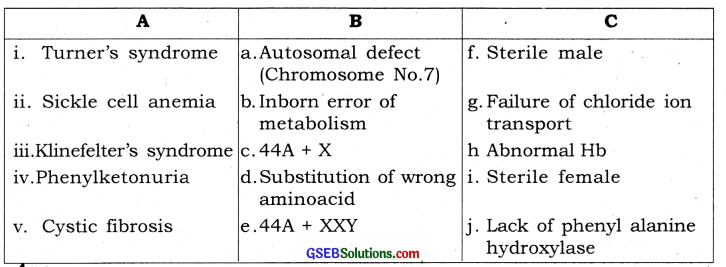
Answer:

Question 48.
Give the chromosome numbers of the following animals and plants.
| Animals | Plants |
| i. Ascaris megalocephala | a. Pisum sativum |
| ii. Drosophila melanogaster | b. Allium cep a |
| iii. Apis (honey bee) | c. Oryza sativa |
| iv. Homosapiens | d. Ophioglossum reticulatum |
| v. Equus (horse) | e. Saccharum officinarum |
| vi. Culex | f. Solanum tuberosum |
Answer:
| Animals | Plants |
| i. 2 | a. 14 |
| ii. 8 | b. 16 |
| iii. 32 | c. 24 |
| iv. 46 | d. 1262 |
| v. 64 | e. 80 |
| vi. 6 | f. 48 |
![]()
Question 49.
Complete the flow chart.
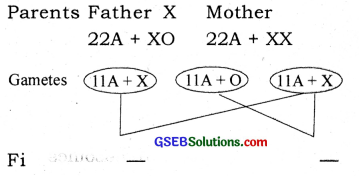
Answer:
XX-XO mechanism :
In many insects and roundworms, the females have two ‘X’ chromosomes (XX) and the males have only one ‘X’ chromosome (XO). The male has one chromosome less than the female.
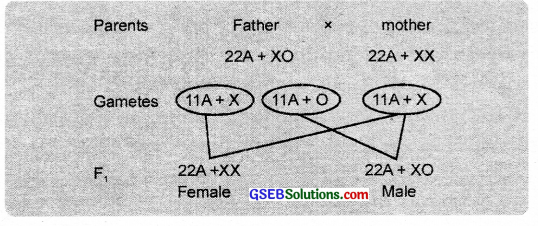
Eg: In grasshopper females have 22 autosomes and two X chromosomes (XX). The males have 22 autosomes and only one ‘X’ chromosome (XO). The female produces only one type of egg with X chromosome. Male produces two types of sperms. One type with 11 A and one X chromosome (11 A + X) and the other type with 11 A only (11A + O). The fusion of X sperm with X egg produces a female (XX). The fusion of O sperm with X egg produces a male (XO).
Question 50.
Correct the amino acid sequence of sickle cell haemoglobin.
![]()
Answer:
![]()
Question 51.
Down’s syndrome may occur in both sexes. Comment.
Answer:
Because Down’s syndrome is an autosomal abnormality in which chromosome number 21 is represented by 3 copies (21 trisomy)
![]()
Question 52.
Chromosome sets of four individuals are given below 45A + XXY, 45A + XO, 45A + XX, 45A + XY.
a. How many body chromosomes and sex chromosomes are present in normal males and females?
b. Identify and write the names of chromosomal abnormalities in the above-listed chromosome sets.
c. Down’s syndrome is seen in both sexes. Comment.
Answer:
a. 22 pairs of autosomes and one pair of allosomes.
b. Klinefelter’s syndrome, Turner’s syndrome, Down’s syndrome (female), Down’s syndrome (male)
c. Down’s syndrome is trisomy in 21st chromosome. Hence autosomal abnormality doesn’t affect sex.
Question 1.
Mendel’s which law of inheritance is universally accepted without any exception? State the law.
Answer:
Mendel’s I law i.e., the law of dominance. The law states that when a pair of contrasting factors for a character are present together, one will dominate over the other.
Question 2.
AaBb was crossed with aabb. What would be the phenotypic ratio of the progeny? Mention the term to denote this kind of cross.
Answer:

![]()
Kind of cross: Test cross between a heterozygous dihybrid and double recessive parents.
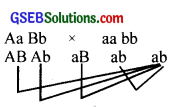
Question 3.
The following table shows the genotypes for ABO blood grouping and their phenotypes. Fill in the gaps left in the table.

Answer:

Question 4.
Describe sex determination in certain Birds.
Answer:
- In birds, sex determination is of ZW type, both males and females have a same number of chromosomes.
- The males have autosomes plus a pair of Z- chromosomes.
- The females along with autosomes ZW chromosomes.
- The males are homogametic and produce sperms carrying one Z – chromosome along with autosomes.
- The females are heterogametic and produce 50% of ova carrying one Z – chromosome and the remaining 50% carrying one W – chromosome.
- The sex of the individual is determined by the type of ovum fertilized.
- When an ovum containing the Z chromosome is fertilized; the zygote (ZZ) develops into males.
- When an ovum containing the W chromosome is fertilized; the zygote (ZW) develops into a female.